The rural township of Ershuei (二水) sits on the Western Rail Line, roughly halfway between the cities of Changhua (彰化) and Chiayi (嘉義).
It’s an unremarkable, if pleasant place, I conclude, while eating my breakfast in a small seated area situated at the middle of roundabout that serves as both bus stop and railway station forecourt.
Under the shade of some strategically planted palm trees, I watch the comings and goings of weekend travelers who alight here and promptly head to the sole branch of OK Mart in search of sustenance. Two cyclists rent bikes and tell me they plan to pedal up to Sun Moon Lake via the Ershuei Bikeway that flanks much of the branch railway line; a hiker armed with a mandatory walking stick is heading to the Fongbo Trail, where, I’ve read, one can be harassed by Formosan macaques in their natural habitat.
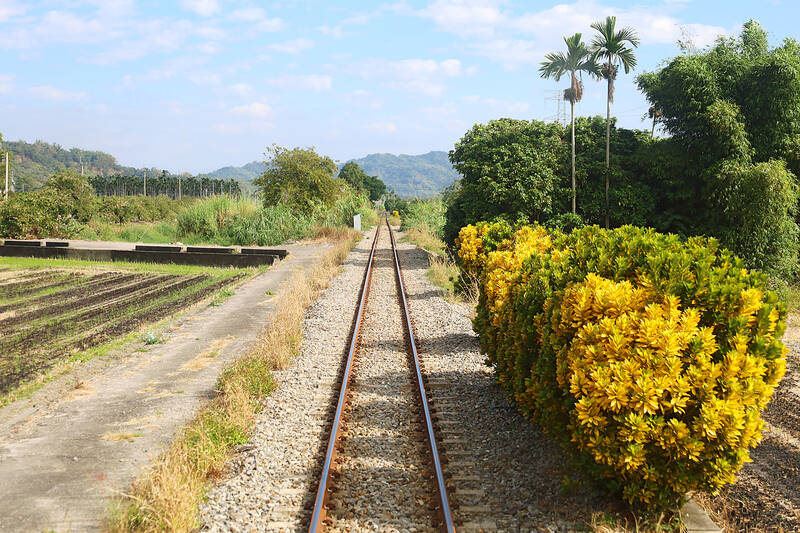
Photo: Thomas Bird, Taipei Times
I can’t help feel I’m the lazier of Ershuei’s morning visitors, as I plan to travel 30km inland and uphill in style, rolling along a hundred-year-old railway of Japanese provenance.
There’s still a few minutes before the scheduled departure, time enough to read-up on the prospective journey, as the uber helpful employee of the Visitor Information Center that abuts Ershuei Station has stockpiled me with enough informative brochures to research a PhD.
The Jiji Line (集集線), I learn, was built between 1919 to 1922, first to transport sugarcane and later to transport materials used to construct a dam, part of a huge hydro-electric project, the Daguan Power Water Plant. Despite its industrial genesis, after the plant was completed in 1934 it continued to be a passenger and freight line to Nantou County.
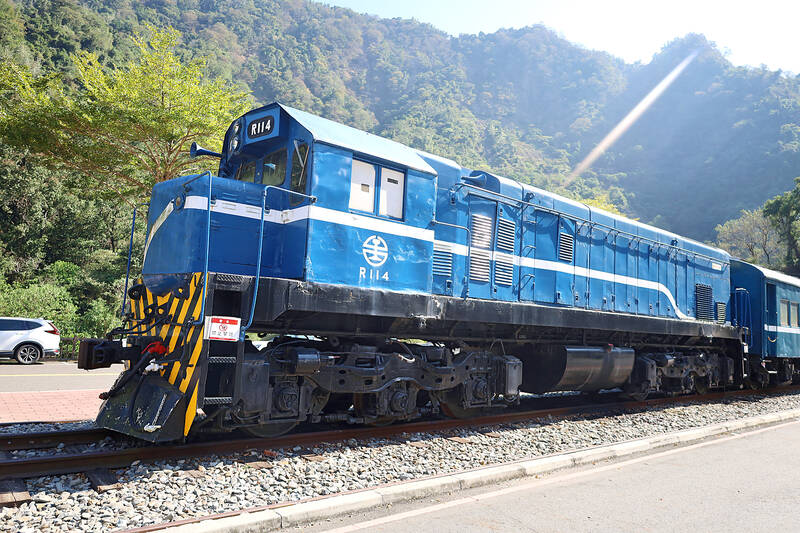
Photo: Thomas Bird, Taipei Times
Although the line’s relevance declined with the rise of automotive culture, it has found new life as a tourist attraction, romantically dubbed “The Nostalgic Railway,” one that promises to be an excursion through “lush green farmlands” along “the Jhuoshuei River.”
ROLLING EAST
The train, somewhat disappointingly, doesn’t have any windows that passengers can open. What is does have is a seat adjacent to the driver’s cab with anterior views of our passage east.
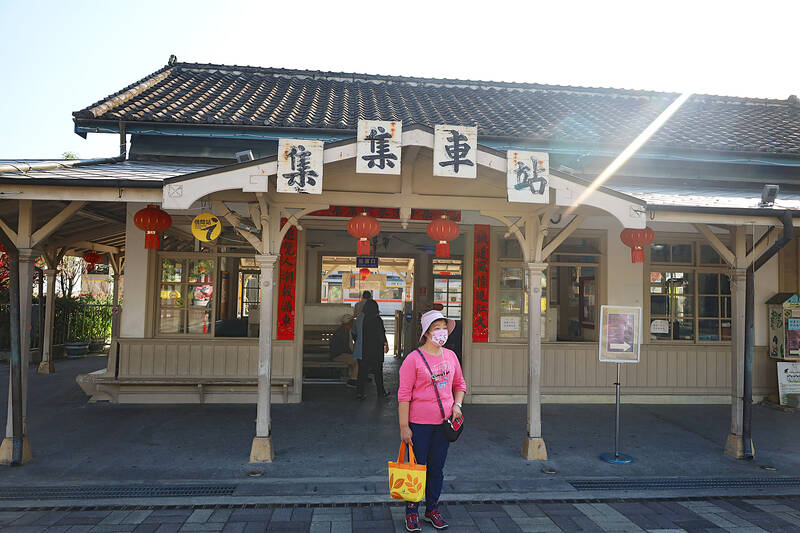
Photo: Thomas Bird, Taipei Times
It’s like being a child allowed to sit in the “front seat” as we make the five-minute hop to the first scheduled stop, the village of Yuancyuan (源泉).
From Yuancyuan, the train rolls into a bucolic realm of fruit groves and tiny farmsteads, betelnut plantations and fields of yellowed cornstalks. In the distance, forest-coated mountains intimate the island’s high-altitude interior.
Around eight kilometers into our journey, we reach Jhuoshuei Station (濁水), flanked by old military warehouses that have been decorated with some colorful murals. Beyond the platform’s edge, the foliage is thick, hanging over the tracks like leafy curtains that brush against the top of the train as it growls against the gradient.
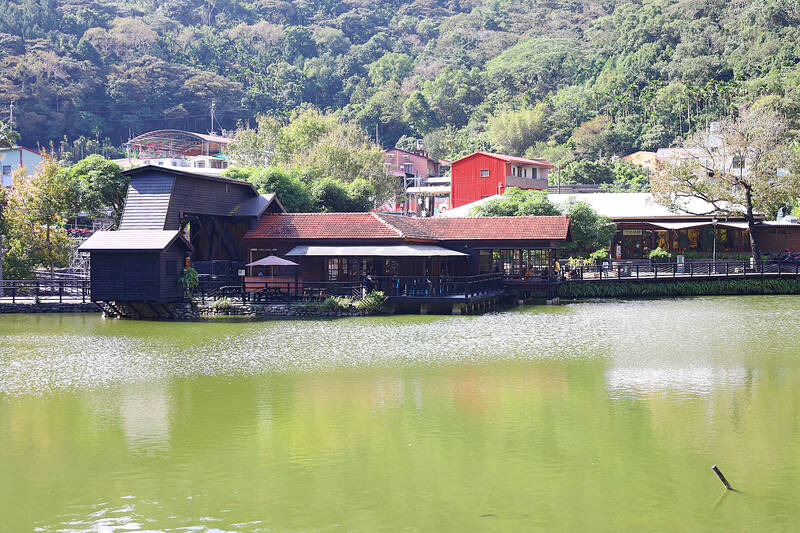
Photo: Thomas Bird, Taipei Times
We’re soon climbing a steep incline, the track winding with the contours of the land.
The train passes through Longcyuan Station (龍泉) 20 minutes into the journey, a twin platform station that sits in the shade of a 100-year-old Chinaberry tree.
After tracing our way further uphill, we enter the Jiji Green Tunnel before arriving at Jiji, the rustic village from which the branch line derives its name.
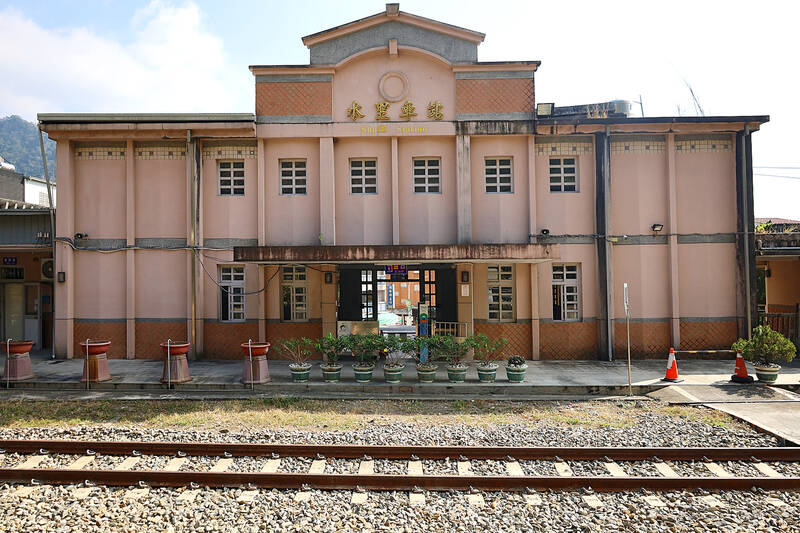
Photo: Thomas Bird, Taipei Times
The main attraction (and principle photo opportunity) is the beautiful wooden stationhouse that dates back to 1933, although it had to be painstakingly reconstructed after the infamous 7.3 magnitude 921 Earthquake that laid waste to much of the region, including the railway line, in 1999. The same red-cypress beams and planks were used (although the main pillars were reinforced with steel) and its black-glazed roof tiles were replaced with those retrieved from other period buildings in the area.
While the building is impressive, the air is perfumed with Jiji’s signature culinary specialty, namely stinky tofu, which prompts me to reboard the train for the remaining 10 kilometers to Checheng (車埕), the terminus of the Jiji branch line.
The largest settlement on the railway is the penultimate station, the former logging town of Shueili (水里) where many affluent timber merchants once lived, earning it the “Little Taipei” moniker in its heyday.

Photo: Thomas Bird, Taipei Times
It’s clearly seen better times, and now resembles a typical Taiwanese town of its size, although the stationhouse is an impressive pink structure constructed on a hillside overlooking the shophouses and riverfront like a colonial villa.
Beyond Shueili, the Jiji line arcs away from the Jhuoshuei River we’ve been following since Ershuei, entering the craggy mountain country that long sat on the horizon.
EXPLORING CHECHENG
The journey concludes at the handsome station of Checheng, another wooden, Japanese building that was rebuilt with cypress wood after the 921 Earthquake.
Backed by a beautiful ridge of tall peaks and fed by the clear water of the Cingshuei River, it’s easy to see why weekenders converge here in large numbers. Many arrive by bus and bicycle, as well as by train.
As well as work in the nearby damn and reservoir, Checheng folk were also employed in the timber trade. The industry reached its zenith in the 1960s and ‘70s when trees felled from the Danda Forest Area were hoisted onto flat cars before being transported to lowland cities by rail. Rice, bananas and other fruit were also transported on the Jiji line.
In Checheng’s Railway Park, old steam locomotives and freight gondolas have been parked up for posterity — relics of time when business boomed.
The twenty-first century incarnation of the town is, however, quite different. Judging by the quantity of knickknack stores and gift shops festooning the place, tourism is Checheng’s lifeblood today. There’s a winery where locally-produced plum wine can be sampled, an impressive lumber museum exhibiting locally-made wood carvings as well as plethora of shops selling everything from mountain tea to freshly made honey.
The Lumber Pond is the main focus of the township, a jade-colored lake stocked with fish and frequented by wild birds. A boardwalk invites a stroll from where one can fully absorb the fine scene in a languid fashion.
Along its shores, some of the better-quality restaurants are located, and having worked up a thirst, I stop by Cedar Tea House (木茶房), a quaint, woody eatery decorated to invoke the days of lumber past.
I order a golden grapefruit tea from the menu then sit down by the window.
“How is your day?” the waitress asks, as she serves me my drink.
“Couldn’t be better,” I reply.

June 23 to June 29 After capturing the walled city of Hsinchu on June 22, 1895, the Japanese hoped to quickly push south and seize control of Taiwan’s entire west coast — but their advance was stalled for more than a month. Not only did local Hakka fighters continue to cause them headaches, resistance forces even attempted to retake the city three times. “We had planned to occupy Anping (Tainan) and Takao (Kaohsiung) as soon as possible, but ever since we took Hsinchu, nearby bandits proclaiming to be ‘righteous people’ (義民) have been destroying train tracks and electrical cables, and gathering in villages

Dr. Y. Tony Yang, Associate Dean of Health Policy and Population Science at George Washington University, argued last week in a piece for the Taipei Times about former president Ma Ying-jeou (馬英九) leading a student delegation to the People’s Republic of China (PRC) that, “The real question is not whether Ma’s visit helps or hurts Taiwan — it is why Taiwan lacks a sophisticated, multi-track approach to one of the most complex geopolitical relationships in the world” (“Ma’s Visit, DPP’s Blind Spot,” June 18, page 8). Yang contends that the Democratic Progressive Party (DPP) has a blind spot: “By treating any

Swooping low over the banks of a Nile River tributary, an aid flight run by retired American military officers released a stream of food-stuffed sacks over a town emptied by fighting in South Sudan, a country wracked by conflict. Last week’s air drop was the latest in a controversial development — private contracting firms led by former US intelligence officers and military veterans delivering aid to some of the world’s deadliest conflict zones, in operations organized with governments that are combatants in the conflicts. The moves are roiling the global aid community, which warns of a more militarized, politicized and profit-seeking trend

This year will go down in the history books. Taiwan faces enormous turmoil and uncertainty in the coming months. Which political parties are in a good position to handle big changes? All of the main parties are beset with challenges. Taking stock, this column examined the Taiwan People’s Party (TPP) (“Huang Kuo-chang’s choking the life out of the TPP,” May 28, page 12), the Democratic Progressive Party (DPP) (“Challenges amid choppy waters for the DPP,” June 14, page 12) and the Chinese Nationalist Party (KMT) (“KMT struggles to seize opportunities as ‘interesting times’ loom,” June 20, page 11). Times like these can